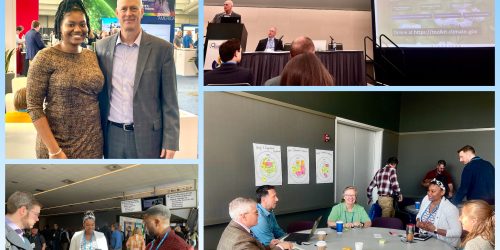Observing the Climate System
International Argo Float Network Celebrates 1 Million Ocean Profiling Milestone
The NOAA Climate Program Office designs, deploys, and maintains an integrated global network of oceanic and atmospheric observing instruments to produce continuous records and analyses of a range of ocean and atmosphere parameters. In 2012, the Argo program, a global array of more than 3,000 autonomous ocean-monitoring floats, collected its one millionth profile of ocean salinity and temperature-a critical milestone in ocean observing science. To put this achievement into context, since the 1890s, oceanographers have collected only about 500,000 profiles in the upper 1,000 meters and only about 200,000 to 2,000 meters of the ocean’s surface. It took Argo floats a dozen years to reach 1 million profiles at these depths, and, but will only take eight years to collect the next million profiles. The use of this sustained dataset can improve projections of sea level rise, better our understanding of climate variability, and offer insights into ocean heat circulation.
Arctic Continues to Break Records in 2012
NOAA’s annual Arctic Report Card, introduced in 2006 by the NOAA Climate Program Office, found that the Arctic region continued to break records in 2012—among them the loss of summer sea ice, spring snow cover, and melting of the Greenland ice sheet. According to the 2012 Arctic Report Card, these converging indicators “provide strong evidence of the momentum that has developed in the Arctic environmental system due to the impacts of a persistent warming trend that began over 30 years ago.” The NOAA Climate.gov team produced visual highlights for the report.
Students Win Chance to Launch a NOAA Global Ocean Drifter for Earth Day
In celebration of Earth Day, students and teachers across the U.S. and in four partnering countries co-adopted drifting buoys as part of NOAA’s Adopt a Drifter Program, established by the NOAA Climate Program Office. Student essay/art contest awardees deployed their school’s drifter from a boat in the nearby Atlantic or Pacific Ocean. Six drifter deployments took place within two weeks of Earth Day in the Dominican Republic, Maui, Seattle, Santa Barbara, Mobile, and Miami. Participating schools tracked their co-adopted drifter for months as it traveled in the Atlantic Ocean. The launches were also supported from nearby facilities, including staff at the Atlantic Oceanographic and Meteorological Laboratory (AOML), the Pacific Marine Environmental Laboratory (PMEL), local National Marine Sanctuaries, sea labs, and aquariums.
Advancing our Understanding of the Climate System
By Air, Land, and Sea: Exploring the Mysteries of the Madden-Julian Oscillation
The Madden–Julian Oscillation, or “MJO,” is the largest element of intraseasonal variability in the tropical atmosphere. The MJO is responsible for sending both enhanced and suppressed waves of tropical rainfall eastward across the Indian Ocean and Pacific Ocean. In 2012, NOAA’s Climate Program Office (CPO) directly supported an international, US-interagency research effort – known as “DYNAMO,” for Dynamics of the Madden-Julian Oscillation – to collect in situ observations of the ocean and the atmosphere over a the Indian Ocean. CPO specifically provided funding for the use of a NOAA WP-3D aircraft and ship time on the R/V Roger Revelle, and supported 21 researchers including NOAA/OAR scientists and external grantees. The observations collected during DYNAMO will help scientists advance their understanding of the MJO, and improve long-range weather forecasts and seasonal outlooks worldwide—perhaps even making the leap to longer-term forecasts of climate extending years into the future.
International Modeling Project Helps Advance Long-Term Climate Outlooks
The international Coupled Model Intercomparison Project (CMIP5), organized and funded by NOAA’s Climate Program Office, has coordinated a major effort to advance long-term climate outlooks for North America. This group has put together a special collection of over 25 papers on climate science that has been submitted to the Journal of Climate and is expected to inform the Fifth Assessment Report of the Intergovernmental Panel on Climate Change, as well as National Climate Assessment activities. This work was a based on a multi-model approach, leveraging and complementing results based on NOAA’s Geophysical Fluid Dynamics Laboratory modeling investigations. This group is composed of approximately 30 scientists from NOAA, academia, and other federal agencies and laboratories, and is a strong example of how NOAA’s grant programs strategically extend NOAA’s research capability.
NOAA Develops New System To Improve Predictions of Atmospheric Conditions
Scientists have developed a climate prediction system with the potential to improve climate and drought prediction skill. The experimental system, named the National Multi-Model Ensemble (NMME), is currently being tested and evaluated. Initial results from this system—the first of its kind in the United States— suggest that the it can consistently rival the best individual models in simulating and predicting atmospheric conditions and climate phenomena, such as the El Nino-Southern Oscillation. Predictions from the NMME are already informing climate forecasts released by the NOAA Climate Prediction Center, one of the National Centers for Environmental Prediction. Twenty years of hindcast data (model reproductions of known observations in the past) and predictions are publicly available to the scientific community, and have rapidly become a major resource for prediction and predictability research. The NOAA Climate Program Office’s Modeling, Analysis, Predictions, and Projections program funded this work in partnership with NASA, NSF, DOE and the external community in the framework of MAPP-NCEP Climate Test Bed activities.
Informing Society:
New National Climate Assessment Report Estimates Global Mean Sea Level Rise
On Dec. 6, 2012, NOAA released a report that estimates global mean sea level rise over the next century based on a comprehensive synthesis of existing scientific literature. The report finds that there is very high confidence (>9 in 10 chances) that global mean sea level (starting in 1992) will rise at least 8 inches (0.2 meters) and no more than 6.6 feet (2 meters) by 2100, depending upon uncertainties associated with ice sheet loss and ocean warming. The report was authored by a panel of scientists from multiple federal agencies and academic institutions, and will be used to support the National Climate Assessment—a U.S. interagency report produced once every four years. Adam Parris of the NOAA Climate Program Office (CPO) served as report lead author, with contributions from many CPO-funded scientists.
Workshop Series: Adaptation Strategies and Information Needs in Response
to Extreme Events
A collaboration between Federal and NGO partners—including the NOAA Climate Program Office’s Sectoral Application Research Program (SARP), Environmental Protection Agency, the Water Environment Research Foundation, the Water Research Federation, Concurrent Technologies Corporation, and NOBLIS—convened a series of workshops in communities that have experienced extreme events and their cascading impacts. In 2012, case study workshops were held in the Russian River Basin, CA; Gwinnett County, GA; Tidewater, VA; and Washington, D.C. Future events planned in the Missouri River Basin and Texas. The objectives of the workshops are to better understand how water utilities had planned for, and responded to, these events, and to learn what information they need to prepare for future events. A newly released case study document summarizes findings from the Gwinnett County, GA, workshop.
Florida’s Fragile Oasis
In a place routinely afflicted by drought, water managers in Tampa Bay use climate forecasts to ensure a water supply to people’s taps without sucking the region’s rivers, wetlands, and groundwater dry. Vasu Misra, a climate researcher from Florida State University, is working with a group of climate researchers and local water managers to unravel some of the climate-related challenges facing them. Funded by the NOAA Climate Program Office’s Modeling, Analysis, Predictions, and Projections (MAPP) program, Misra is investigating local-scale climate impacts, including the variability and predictability of tropical storms in the Western Atlantic that can deliver a large percentage of precipitation to areas of Florida. In addition to this research, Misra is also helping water managers by downscaling climate models, an effort is funded in part by the Sectoral Applications Research Program. Read more about what it takes to supply Tampa’s growing population with the water they need, now and in years to come, on NOAA Climate.Gov.
Read more about the Top NOAA Research Accomplishments in 2012 online.










